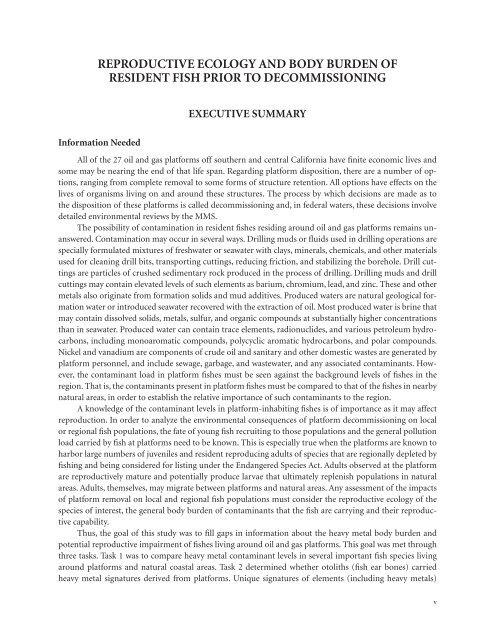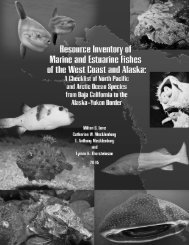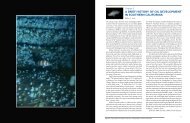Reproductive Ecology and Body Burden of Resident ... - The Love Lab
Reproductive Ecology and Body Burden of Resident ... - The Love Lab
Reproductive Ecology and Body Burden of Resident ... - The Love Lab
Create successful ePaper yourself
Turn your PDF publications into a flip-book with our unique Google optimized e-Paper software.
REPRODUCTIVE ECOLOGY AND BODY BURDEN OF<br />
RESIDENT FISH PRIOR TO DECOMMISSIONING<br />
EXECUTIVE SUMMARY<br />
Information Needed<br />
All <strong>of</strong> the 27 oil <strong>and</strong> gas platforms <strong>of</strong>f southern <strong>and</strong> central California have finite economic lives <strong>and</strong><br />
some may be nearing the end <strong>of</strong> that life span. Regarding platform disposition, there are a number <strong>of</strong> options,<br />
ranging from complete removal to some forms <strong>of</strong> structure retention. All options have effects on the<br />
lives <strong>of</strong> organisms living on <strong>and</strong> around these structures. <strong>The</strong> process by which decisions are made as to<br />
the disposition <strong>of</strong> these platforms is called decommissioning <strong>and</strong>, in federal waters, these decisions involve<br />
detailed environmental reviews by the MMS.<br />
<strong>The</strong> possibility <strong>of</strong> contamination in resident fishes residing around oil <strong>and</strong> gas platforms remains unanswered.<br />
Contamination may occur in several ways. Drilling muds or fluids used in drilling operations are<br />
specially formulated mixtures <strong>of</strong> freshwater or seawater with clays, minerals, chemicals, <strong>and</strong> other materials<br />
used for cleaning drill bits, transporting cuttings, reducing friction, <strong>and</strong> stabilizing the borehole. Drill cuttings<br />
are particles <strong>of</strong> crushed sedimentary rock produced in the process <strong>of</strong> drilling. Drilling muds <strong>and</strong> drill<br />
cuttings may contain elevated levels <strong>of</strong> such elements as barium, chromium, lead, <strong>and</strong> zinc. <strong>The</strong>se <strong>and</strong> other<br />
metals also originate from formation solids <strong>and</strong> mud additives. Produced waters are natural geological formation<br />
water or introduced seawater recovered with the extraction <strong>of</strong> oil. Most produced water is brine that<br />
may contain dissolved solids, metals, sulfur, <strong>and</strong> organic compounds at substantially higher concentrations<br />
than in seawater. Produced water can contain trace elements, radionuclides, <strong>and</strong> various petroleum hydrocarbons,<br />
including monoaromatic compounds, polycyclic aromatic hydrocarbons, <strong>and</strong> polar compounds.<br />
Nickel <strong>and</strong> vanadium are components <strong>of</strong> crude oil <strong>and</strong> sanitary <strong>and</strong> other domestic wastes are generated by<br />
platform personnel, <strong>and</strong> include sewage, garbage, <strong>and</strong> wastewater, <strong>and</strong> any associated contaminants. However,<br />
the contaminant load in platform fishes must be seen against the background levels <strong>of</strong> fishes in the<br />
region. That is, the contaminants present in platform fishes must be compared to that <strong>of</strong> the fishes in nearby<br />
natural areas, in order to establish the relative importance <strong>of</strong> such contaminants to the region.<br />
A knowledge <strong>of</strong> the contaminant levels in platform-inhabiting fishes is <strong>of</strong> importance as it may affect<br />
reproduction. In order to analyze the environmental consequences <strong>of</strong> platform decommissioning on local<br />
or regional fish populations, the fate <strong>of</strong> young fish recruiting to those populations <strong>and</strong> the general pollution<br />
load carried by fish at platforms need to be known. This is especially true when the platforms are known to<br />
harbor large numbers <strong>of</strong> juveniles <strong>and</strong> resident reproducing adults <strong>of</strong> species that are regionally depleted by<br />
fishing <strong>and</strong> being considered for listing under the Endangered Species Act. Adults observed at the platform<br />
are reproductively mature <strong>and</strong> potentially produce larvae that ultimately replenish populations in natural<br />
areas. Adults, themselves, may migrate between platforms <strong>and</strong> natural areas. Any assessment <strong>of</strong> the impacts<br />
<strong>of</strong> platform removal on local <strong>and</strong> regional fish populations must consider the reproductive ecology <strong>of</strong> the<br />
species <strong>of</strong> interest, the general body burden <strong>of</strong> contaminants that the fish are carrying <strong>and</strong> their reproductive<br />
capability.<br />
Thus, the goal <strong>of</strong> this study was to fill gaps in information about the heavy metal body burden <strong>and</strong><br />
potential reproductive impairment <strong>of</strong> fishes living around oil <strong>and</strong> gas platforms. This goal was met through<br />
three tasks. Task 1 was to compare heavy metal contaminant levels in several important fish species living<br />
around platforms <strong>and</strong> natural coastal areas. Task 2 determined whether otoliths (fish ear bones) carried<br />
heavy metal signatures derived from platforms. Unique signatures <strong>of</strong> elements (including heavy metals)<br />
v




